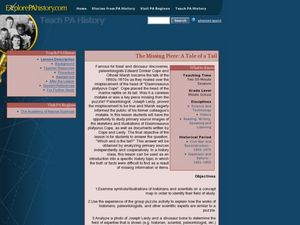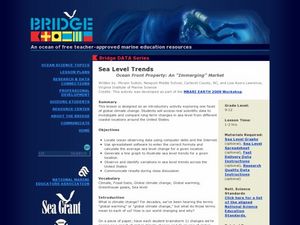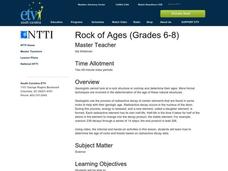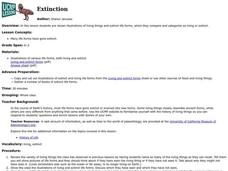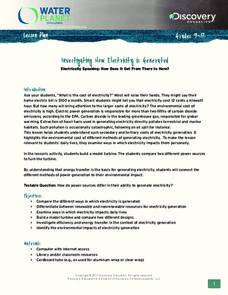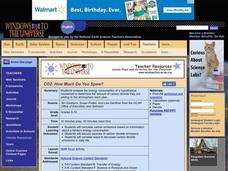Curated OER
Cell Structure and Function
Students discuss scientific advances brought about by the Mars Surveyor Space Program which impact on daily life, identify laboratory apparatus like microscopes, slides and coverslips, and use the microscopes to view cells and organisms.
Curated OER
The Missing Piece: A Tale of a Tail
Students analyze and write about their findings of the dinosaur discoveries of Edward Cope. For this Edward Cope lesson plan, students examine illustrations of concept maps, discuss challenges, analyze skeleton diagrams, and write...
Curated OER
Neanderthals
Students study Neanderthals. In this Prehistoric life lesson, students investigate two main theories regarding the relationship between Neanderthals and modern man. Students will conduct research through several provided web sites and...
Curated OER
Sea Level Trends ~ Ocean Front Property: An "Immerging" Market
Young oceanographers take a look at sea level data from several cities over a few centuries. They use the data to fuel a discussion about what kind of changes are taking place and the impact they are having on the coastal ecosystems....
Curated OER
Powering a Green Earth
Pupils compare and contrast renewable and nonrenewable energy. In this environmental science lesson, students discuss the importance of going green. They identify the different components in a power grid system.
Curated OER
The Paleozoic Era
Students access prior knowledge to create a chart of eras. For this Paleozoic era lesson, students research the Paleozoic era to find information to create dioramas. Students participate in fossil activities.
Curated OER
Rock of Ages
Middle schoolers use a video, the Internet and hands-on activities to explore how to determine the age of rocks and fossils based on radioactive decay data.
Curated OER
Who Was Here First? Relative Dating
Young scholars read about and complete question activities for the topic of relative dating. For this relative dating lesson, students read information for the topic and then complete two activities to further their understanding of...
Curated OER
How do we know that the theory of evolution is correct?
Students read passages and view a slide show on the theory of evolution and provide evidence that this theory is correct. For this evolution lesson plan, students read about fossils, anatomy, organs, fetal development, and more.
Curated OER
Human Evolution: Biology, Bones
Learners will love a weeks worth of bone study. They use bones and characteristics of bones to explore the evolution of hominoids. Bones are compared, categorized, and considered. A great way to bring physical anthropology and material...
Curated OER
Extinction
Students peruse illustrations of living things and extinct life forms, which they compare and categorize as living or extinct.
Curated OER
Water and Ice
Students observe what happens to water as it goes from a solid to a liquid. In this exploratory lesson plan students gain an understanding for the water cycle while working in groups observing what happens to water as it changes...
Curated OER
The African Burial Ground
Pupils analyze African American burial grounds. In this African American history lesson, students draw conclusions about African American communities in early New York and consider how archeology made it possible to study the communities.
Curated OER
The African Burial Ground
Fourth graders analyze findings at African burial grounds. For this research skills lesson, 4th graders research Internet and print sources regarding African American heritage. Students discuss their findings.
EngageNY
TASC Transition Curriculum: Workshop 9
Here's a workshop for teachers that rocks the academic world! Using earthquakes as a medium for instruction, educators learn about crosscutting engineering with science. Fun, hands-on, collaborative exercises encourage participants to...
Curated OER
Hometown Ecology
Young scholars examine how ecology is at work in their own community. As a class, they identify what they already know about the world around them and discuss how they personally affect the environment. Using magazines, newspapers and...
EarthEcho International
Investigating How Electricity is Generated
What is the real cost of electricity? The real cost is not just the price you pay, but the environmental and economic costs as well. Scholars build, use, and judge the effectiveness of a turbine. They also investigate the...
California Academy of Science
Natural Resources Bingo
Bingo isn't just a silly game, it's a great way to practice all types of skills. After reviewing that the earth is composed of natural resources, what those natural resources are, and sustainability, the class plays a game of bingo. The...
Curated OER
Sources of Energy
Fifth graders take a close look at how energy changes from one form to another within their surroundings. They also study the ten different sources of energy and determine which are renewable and which are non-renewable. This seven-page...
Curated OER
A Scientific Approach to Teaching about Evolution
Students examine fossils and analyzing their significance in relation to theories of evolution. Hand-outs are provided. This lesson could be supplementary to a broader unit on evolution or geology.
Curated OER
Species Diversity and Phylogeny
Students explore the classification system of organisms: taxonomy. They examine prepared slides of Protozoans and record information on a Taxonomy Recording Sheet. Two additional classifying activities are also included in this lesson.
Curated OER
The Ice Age
Students study the differences in the Ice Age terminology and what causes them. For this Ice Age lesson students examine what plants and animals lived during the Ice Age.
Curated OER
Photosynthesis and Biomass Growth
Sixth graders examine renewable energy sources such as ethanol. In this photosynthesis and biomes lesson students complete a project on farming techniques.
Curated OER
CO2: How Much Do You Spew?
Students analyze the energy consumption of a household to see the amount of carbon dioxide they add to the atmosphere each year. In this energy consumption activity students calculate carbon emissions and discuss sources of carbon...



